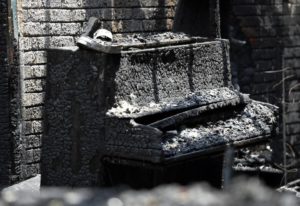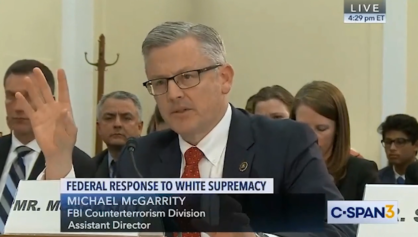
Charred remains of Briar Creek Briar Road Baptist Church in Charlotte, N.C. / Davie Hinshaw, Charlotte Observer
In the wake of the Charleston Massacre, Black churches are once again burning across the south, and the federal government is investigating these as possible hate crimes. At a time when the federal government regards ISIS and other Islamic terrorist groups as an existential threat to the security of the United States, the recent rash of suspected arson cases raises questions as to whether the domestic threat from white supremacist terrorist groups will be addressed.
At least six predominantly Black churches have burned in five southern states in the week following the shooting deaths of nine Black congregants at Emanuel AME Church in Charleston, S.C. On June 17, Dylann Roof, 21, gunned down a Bible study group because he said he wanted to kill Blacks and start a race war. The murders prompted calls for the removal of the Confederate battle flag from the South Carolina statehouse grounds and elsewhere, given Roof’s affinity for the flag.
The first fire took place on June 21 at College Hill Seventh Day Adventist Church in Knoxville, Tenn. According to WATE-TV, stacks of hay and soil were placed against the church doors and set ablaze.
On June 23, God’s Power Church of Christ in Macon, Ga. was set on fire, and ruled an arson by authorities, as the front doors were locked and a side door of the building had been opened.
Briar Creek Road Baptist Church in Charlotte, N.C. sustained $250,000 in damage and destruction of the main building from a June 24 fire, as was reported in the Washington Post. The burning church required 75 firefighters to get the blaze under control. Also that day, a fire destroyed Fruitland Presbyterian Church in Gibson, Tenn., although authorities have not ruled out lightning as the cause of that blaze.
On June 26, hours before President Obama gave the eulogy for State Senator Clementa Pinckney, the reverend of Emanuel AME who was gunned down with his parishioners, Grover Glove Baptist Church in Warrenville, S.C. burned to the ground. Early that morning, Greater Miracle Temple Apostolic Holiness Church in Tallahassee, Fla. had gone up in flames as well, possibly due to electrical wiring, but federal authorities are investigating.
Meanwhile, on June 27, a seventh church outside of the south, College Heights Baptist Church in Elyria, Ohio, also caught fire, and an investigation is underway.
The Southern Poverty Law Center, which monitors hate group activity, concludes the rash of fires “may not be a coincidence” given the timing of the fires.
Historically, Black churches have been targets of arson by white supremacist groups. As the oldest Black church in the south, Emanuel AME had itself succumbed to arson for its role in the Denmark Vesey slave rebellion in 1822. During the civil rights movement, churches such as the Sixteenth Street Baptist Church in Birmingham, Ala. were firebombed. In addition, the epidemic of Black church fires in the 1990s prompted President Bill Clinton to sign the Church Arson Prevention Act, which increased prison time for those who set churches on fire.
Meanwhile, the federal government is well acquainted with white supremacist domestic terrorism, beginning with the Civil Rights Act of 1871, also known as the Ku Klux Klan Act. Enacted by Congress during Reconstruction to protect African Americans from the Klan, the law allowed civil and criminal penalties for conspiratorial racial violence against Black people. The Act also gave the President the power to suspend the writ of habeas corpus—where people can challenge their unlawful detention or imprisonment—to fight the Klan, which President Grant used once to fight Klan terrorism in ten South Carolina counties.
Years later, the Department of Homeland Security warned in 2009 that rightwing extremists and militias were organizing and on the rise, united by an ailing economy and the election of a Black president. And yet, it appears that in light of the Charleston massacre and the recent wave of Black church burnings that have followed, those warnings were ignored.


